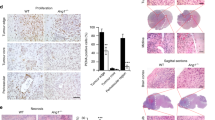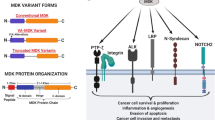Abstract
Tumor angiogenesis is essential for tumor growth and metastasis and is dependent on key angiogenic factors. Angiogenin (ANG), a 14.2-kDa polypeptide member of the RNase A superfamily, is an angiogenic protein that has been reported to be upregulated and associated with poor prognosis in some human cancers. The mechanisms through which aberrant ANG levels promote specific steps in tumor progression are unknown. Here, we show that ANG expression in human tissues is strongly correlated with an invasive cancer phenotype. We also show that ANG induces cellular survival, proliferation, endothelial tube formation and xenograft angiogenesis and growth. Novel mechanistic investigations revealed that ANG expression stimulated matrix metallopeptidase-2 (MMP2) expression through the phosphorylation of ERK1/2. Targeting ANG in vivo with N65828, a small-molecule inhibitor of the ribonucleolytic activity of human ANG, resulted in the diminution of xenograft tumoral growth through the inhibition of angiogenesis. Our findings support an unrecognized interplay between ANG, ERK1/2 and MMP2 that can impact tumor growth and progression. The targeting of ANG and associated factors could provide a novel strategy to inhibit tumor establishment and growth.
This is a preview of subscription content, access via your institution
Access options
Subscribe to this journal
Receive 50 print issues and online access
$259.00 per year
only $5.18 per issue
Buy this article
- Purchase on Springer Link
- Instant access to full article PDF
Prices may be subject to local taxes which are calculated during checkout







Similar content being viewed by others
References
Folkman J . Angiogenesis in cancer, vascular, rheumatoid, and other diseases. Nat Med 1985; 1: 27–31.
Folkman J, Klagsbrun M . Angiogenic factors. Science 1987; 235: 442–447.
Hanahan D, Folkman J . Patterns and emerging mechanisms of the angiogenic switch during tumorigenesis. Cell 1996; 86: 353–364.
Liotta LA, Kleinerman J, Saidel GM . Quantitative relationships of intravascular tumor cells, tumor vessels, and pulmonary metastases following tumor implantation. Cancer Res 1974; 34: 997–1003.
Weidner N, Folkman J, Pozza F, Bevilacqua P, Allred EN, Moore DH et al. Tumor angiogenesis: a new significant and independent prognostic indicator in early stage breast carcinoma. J Natl Cancer Inst 1992; 84: 1875–1887.
Bochner BH, Cote RJ, Weidner N . Angiogenesis in bladder cancer: relationship between microvessel density and tumor prognosis. J Natl Cancer Inst 1995; 87: 1603–1612.
Klagsbrun M, D’Amore PA . Regulators of angiogenesis. Ann Rev Physiol 1991; 53: 217–239.
Liotta LA, Steeg PS, Stetler-Stevenson WG . Cancer metastasis and angiogenesis: an imbalance of positive and negative regulation. Cell 1991; 64: 327–336.
Grossfeld GD, Ginsberg DA, Stein JP . Thrombospondin-1 expression in bladder cancer: association with p53 alterations, tumor angiogenesis, and tumor progression. J Natl Cancer Inst 1997; 89: 219–227.
O'Brien T, Cranston D, Fuggle S, Bicknell R, Harris AL . Two mechanisms of basic fibroblast growth factor-induced angiogenesis in bladder cancer. Cancer Res 1997; 57: 136–140.
Köllermann J, Helpap B . Expression of vascular endothelial growth factor (VEGF) and VEGF receptor Flk-1 in benign, premalignant, and malignant prostate tissue. Am J Clin Pathol 2001; 116: 115–121.
Inoue K, Slaton JW, Eve BY, Kim SJ, Perrotte P, Balbay MD et al. Interleukin 8 expression regulates tumorigenicity and metastases in androgen-independent prostate cancer. Clin Cancer Res 2000; 6: 2104–2119.
Uehara H, Troncoso P, Johnston D, Bucana CD, Dinney C, Dong Z et al. Expression of interleukin-8 gene in radical prostatectomy specimens is associated with advanced pathologic stage. Prostate 2005; 64: 40–49.
O'Brien TS, Fox SB, Dickenson AJ, Turley H, Westwood M, Moghaddam A et al. Expression of the angiogenic factor thymidine phosphorylase/platelet-derived endothelial cell growth factor in primary bladder cancers. Cancer Res 1996; 56: 4799–4804.
Fett JW, Strydom DJ, Lobb RR, Alderman EM, Bethune JL, Riordan JF et al. Isolation and characterization of angiogenin, an angiogenic protein from human carcinoma cells. Biochemistry 1985; 24: 5480–5486.
Nilsson UW, Abrahamsson A, Dabrosin C . Angiogenin regulation by estradiol in breast tissue: tamoxifen inhibits angiogenin nuclear translocation and antiangiogenin therapy reduces breast cancer growth in vivo. Clin Cancer Res 2010; 16: 3659–3669.
Katona TM, Neubauer BL, Iversen PW, Zhang S, Baldridge LA, Cheng L . Elevated expression of angiogenin in prostate cancer and its precursors. Clin Cancer Res 2005; 11: 8358–8363.
Hisai H, Kato J, Kobune M, Murakami T, Miyanishi K, Takahashi M et al. Increased expression of angiogenin in hepatocellular carcinoma in correlation with tumor vascularity. Clin Cancer Res 2003; 9: 4852–4859.
Urquidi V, Goodison S, Cai Y, Sun Y, Rosser CJ . A candidate molecular biomarker panel for the detection of bladder cancer. Cancer Epidemiol Biomarkers Prev 2012; 21: 2149–2158.
Goodison S, Chang M, Dai Y, Urquidi V, Rosser CJ . A multi-analyte assay for the non-invasive detection of bladder cancer. PLoS One 2012; 7: e47469.
Miyake H, Hara I, Yamanaka K, Gohji K, Arakawa S, Kamidono S . Increased angiogenin expression in the tumor tissue and serum of urothelial carcinoma patients is related to disease progression and recurrence. Cancer 1999; 86: 316–324.
Hartmann A, Kunz M, Köstlin S, Gillitzer R, Toksoy A, Bröcker EB et al. Hypoxia-induced up-regulation of angiogenin in human malignant melanoma. Cancer Res 1999; 59: 1578–1583.
Tsuji T, Sun Y, Kishimoto K, Olson KA, Liu S, Hirukawa S et al. Angiogenin is translocated to the nucleus of HeLa cells and is involved in ribosomal RNA transcription and cell proliferation. Cancer Res 2005; 65: 1352–1360.
Kao RY, Jenkins JL, Olson KA, Key ME, Fett JW, Shapiro R . A small-molecule inhibitor of the ribonucleolytic activity of human angiogenin that possesses antitumor activity. Proc Natl Acad Sci USA 2002; 99: 10066–10071.
Yoshioka N, Wang L, Kishimoto K, Tsuji T, Hu GF . A therapeutic target for prostate cancer based on angiogenin-stimulated angiogenesis and cancer cell proliferation. Proc Natl Acad Sci USA 2006; 103: 14519–14524.
Moroianu J, Riordan JF . Nuclear translocation of angiogenin in proliferating endothelial cells is essential to its angiogenic activity. Proc Natl Acad Sci USA 1994; 91: 1677–1681.
Shapiro R, Ruiz-Gutierrez M, Chen CZ . Analysis of the interactions of human ribonuclease inhibitor with angiogenin and ribonuclease A by mutagenesis: importance of inhibitor residues inside versus outside the C-terminal ‘hot spot’. J Mol Biol 2000; 302: 497–519.
Lee FS, Vallee BL . Characterization of ribonucleolytic activity of angiogenin towards tRNA. Biochem Biophys Res Commun 1989; 161: 121–126.
Cantwell-Dorris ER, O'Leary JJ, Sheils OM . BRAF V600E: implications for carcinogenesis and molecular therapy. Mol Cancer Ther 2011; 10: 385–394.
Knowles MA . Molecular subtypes of bladder cancer: Jekyll and Hyde or chalk and cheese? Carcinogenesis 2006; 27: 361–373.
Tello-Montoliu A, Patel JV, Lip GY . Angiogenin: a review of the pathophysiology and potential clinical applications. J Thromb Haemost 2006; 4: 1864–1874.
Zhao H, Grossman HB, Delclos GL, Hwang LY, Troisi CL, Chamberlain RM et al. Increased plasma levels of angiogenin and the risk of bladder carcinoma: from initiation to recurrence. Cancer 2005; 104: 30–35.
Piccoli R, Olson KA, Vallee BL, Fett JW . Chimeric anti-angiogenin antibody cAb 26-2F inhibits the formation of human breast cancer xenografts in athymic mice. Proc Natl Acad Sci USA 1998; 95: 4579–4583.
Hirukawa S, Olson KA, Tsuji T, Hu GF . Neamine inhibits xenografic human tumor growth and angiogenesis in athymic mice. Clin Cancer Res 2005; 11: 8745–8752.
Kessenbrock K, Plaks V, Werb Z . Matrix metalloproteinases: regulators of the tumor microenvironment. Cell 2010; 141: 52–67.
Hu GF, Strydom DJ, Fett JW, Riordan JF, Vallee BL . Actin is a binding protein for angiogenin. Proc Natl Acad Sci USA 1993; 90: 1217–1221.
Hu GF, Chang SI, Riordan JF, Vallee BL . An angiogenin-binding protein from endothelial cells. Proc Natl Acad Sci USA 1991; 88: 2227–2231.
Hu G, Riordan JF, Vallee BL . Angiogenin promotes invasiveness of cultured endothelial cells by stimulation of cell-associated proteolytic activities. Proc Natl Acad Sci USA 1994; 91: 12096–12100.
Chuang CK, Pang ST, Chuang TJ, Liao SK . Profiling of matrix metalloproteinases and tissue inhibitors of metalloproteinases proteins in bladder urothelial carcinoma. Oncol Lett 2010; 1: 691–695.
Kumar B, Koul S, Petersen J, Khandrika L, Hwa JS, Meacham RB et al. p38 mitogen-activated protein kinase-driven MAPKAPK2 regulates invasion of bladder cancer by modulation of MMP2 and MMP-9 activity. Cancer Res 2010; 70: 832–841.
Gontero P, Banisadr S, Frea B, Brausi M . Metastasis markers in bladder cancer: a review of the literature and clinical considerations. Eur Urol 2004; 46: 296–311.
Miyake M, Lawton A, Goodison S, Urquidi V, Gomes-Giacoia E, Zhang G et al. Chemokine (C-X-C) ligand 1 (CXCL1) protein expression is increased in aggressive bladder cancers. BMC Cancer 2013; 13: 322–325.
Miyake M, Goodison S, Giacoia EG, Rizwani W, Ross S, Rosser CJ . Influencing factors on the NMP-22 urine assay: an experimental model. BMC Urol 2012; 12: 23.
Anai S, Goodison S, Shiverick K, Hirao Y, Brown BD, Rosser CJ . Knock-down of Bcl-2 by antisense oligodeoxynucleotides induces radiosensitization and inhibition of angiogenesis in human PC-3 prostate tumor xenografts. Mol Cancer Ther 2007; 6: 101–111.
Pfaffl MW . A new mathematical model for relative quantification in real-time RT-PCR. Nucleic Acids Res 2001; 29: e45.
Sakai Y, Goodison S, Cao W, Urquidi V, Namiki K, Porvasnik S et al. VEGF induces expression of Bcl-2 and multiple signaling factors in microvascular endothelial cells in a prostate cancer model. World J Urol 2009; 27: 659–666.
Anai S, Sakamoto N, Sakai Y, Tanaka M, Porvasnik S, Urbanek C et al. Dual targeting of Bcl-2 and VEGF: a potential strategy to improve therapy for prostate cancer. Urol Oncol 2011; 29: 421–429.
Acknowledgements
This work was funded by Florida Biomedical Program James and Esther King Team Science Project 1KT-01 (CJR). Dr Kwai Wa Cheng for reading this manuscript and offering editorial suggestions.
Author information
Authors and Affiliations
Corresponding author
Ethics declarations
Competing interests
The Florida Biomedical Program James and Esther King Team Science Project 1KT-01 funded Dr Rosser’s work. Furthermore, Drs Rosser and Goodison are officers in Nonagen Bioscience Corporation.
Additional information
Supplementary Information accompanies this paper on the Oncogene website
Rights and permissions
About this article
Cite this article
Miyake, M., Goodison, S., Lawton, A. et al. Angiogenin promotes tumoral growth and angiogenesis by regulating matrix metallopeptidase-2 expression via the ERK1/2 pathway. Oncogene 34, 890–901 (2015). https://doi.org/10.1038/onc.2014.2
Received:
Revised:
Accepted:
Published:
Issue Date:
DOI: https://doi.org/10.1038/onc.2014.2
Keywords
This article is cited by
-
Modelling the complex nature of the tumor microenvironment: 3D tumor spheroids as an evolving tool
Journal of Biomedical Science (2024)
-
Transcriptomic analysis of glucosidase II beta subunit (GluIIß) knockout A549 cells reveals its roles in regulation of cell adhesion molecules (CAMs) and anti-tumor immunity
BMC Genomics (2024)
-
RAGE inhibitor TTP488 (Azeliragon) suppresses metastasis in triple-negative breast cancer
npj Breast Cancer (2023)
-
PAI-1 is a potential transcriptional silencer that supports bladder cancer cell activity
Scientific Reports (2022)
-
Construction of transplantable artificial vascular tissue based on adipose tissue-derived mesenchymal stromal cells by a cell coating and cryopreservation technique
Scientific Reports (2021)



